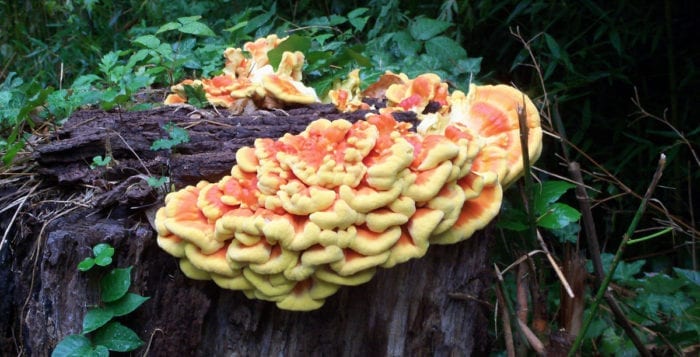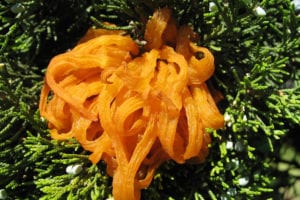Fungus on trees, shrubs and annuals

By Ellen Barcel
One of the things that a gardener needs to do is to identify fungi on plants and take appropriate steps to control the fungi (if possible) if it is detrimental to the plant. But not all fungi will kill plants. Some just make the plant look bad. And some actually are beneficial.
In the past, I’ve had several trees which didn’t survive because of fungus. My beautiful mimosa trees died due to a fungus (mimosa wilt) which could not be stopped at the time. Leaves turned yellow in midsummer and dropped. The tree never sprouted the following growing season. The trees literally died within a few weeks.
A rust killed a mountain ash I had. I was really disappointed, and missed the beautiful orange berries the tree bore and which persisted on the tree well into winter. Mountain ash is a native of North America and has white flowers in spring.
Cedar apple rust can also be found on trees on Long Island. It particularly attacks cedar, apple and crabapple trees. The fruiting body develops as a brownish growth on the tree. Then orange tentacles emerge from the growth. The rust is not fatal to the tree but definitely unsightly, almost looking like something out of a sci-fi movie. Remove the growth making sure to sterilize gardening tools afterwards, so as not to spread the pathogen to other trees.

Now for some generalities on fungal diseases and their prevention:
■ First of all, weak plants are more prone to getting a fungal disease than strong ones. So, make sure you feed and water your plants appropriately.
■ Plants that are crowded with no air circulation are also more prone to fungal diseases.
■ It’s better to water plants at ground level, especially in the evening, so leaves don’t stay wet overnight. A drip irrigation system works well sending water to the roots and not the leaves.
■ Look for fungus-resistant plants such as rust resistant apple and crabapple trees, tomatoes which are resistant to tomato blight, roses resistant to black spot, etc. The tomato blight, for example, will prevent you from getting a decent crop of tomatoes. So this one definitely falls in the bad category.
■ Know that some trees are prone to the fungal disease anthracnose, but generally it is more unsightly, than dangerous. Maples and catalpas in particular develop it in humid weather. The leaves look like they are covered with a white power. Unless the tree is very old and weak it will usually survive with no treatment at all. So, this is a case of ugly, but not really dangerous. When anthracnose develops on the native dogwood (Cornus florida), however, it is much more serious. This is why some recommend planting other varieties of dogwood.
■ Replace plants that are prone to fungal diseases with those with similar attributes but which don’t contract certain diseases. For example, impatiens in recent years have been attacked by a fungus. They are annuals that do well and bring color to shady areas. Instead, plant coleus which are also annuals that do well and bring color to shady areas but are not prone to fungal diseases.
■ If you see a fungus growing on a live tree, check out that tree carefully. Usually large fungi only grow on dead or dying trees. I missed this important sign a number of years ago. An enormous section of one of my maple trees broke off the tree and landed across the street. An arborist gave me the bad news that my tree was dying and needed to be removed. I now check periodically to see if any large fungi are growing on my trees.
Now for the good: Some edible fungi, such as chicken fungi (Chicken of the Woods, Laetiporus sulphureus), grow on dead or dying trees or tree stumps. Be very careful here, as most fungi are not safe to eat. Make sure you check this out with an expert. Also, fungi with large, visible fruiting bodies help to break down dead wood, i.e., the cycle of nature, returning nutrients to the soil. Toad stools growing in the grass help to break down organic matter as well.
Ellen Barcel is a freelance writer and master gardener. Send your gardening questions to [email protected]. To reach Cornell Cooperative Extension and its Master Gardener program, call 631-727-7850.






